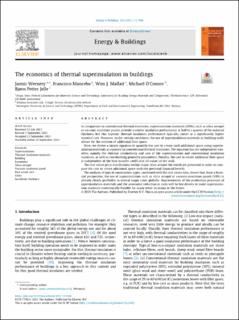| dc.description.abstract | In comparison to conventional thermal insulators, superinsulation materials (SIMs), such as silica aerogel or vacuum insulation panels, provide a similar insulation performance at half to a quarter of the material thickness but this superior thermal insulation performance typically comes at a significantly higher material cost. However, under certain conditions, the use of superinsulation materials in building walls allows for the creation of additional floor space.
Here, we derive a simple equation to quantify the cost to create such additional space using superinsulation materials as opposed to conventional thermal insulators. The equation has six independent variables, namely the thermal conductivity and cost of the superinsulation and conventional insulation materials, as well as two building geometry parameters. Notably, the cost to create additional floor space is independent of the heat transfer coefficient (U-value) of the wall.
The real estate price distributions within major cities around the world are presented in order to compare the cost to create additional space with the potential financial benefit.
The analysis of typical construction types, combined with the real estate data, shows that, from a financial perspective, the use of superinsulation such as silica aerogel or vacuum insulation panels (VIPs) is already clearly profitable in several major cities globally. Improvements of the production processes of superinsulation materials and the associated reduction in costs will be key drivers to make superinsulation materials economically feasible for many other locations in the future. | en_US |

